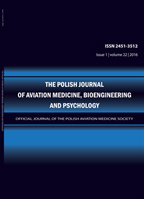2022, Volume 28, Issue 1
CARCINOGENIC FACTORS IN THE MILITARY ENVIRONMENT: THREATS AND CHALLENGES TO THE HEALTH OF SOLDIERS AND MILITARY PERSONNEL
MAGDALENA ZAWADZKA1, MARCIN NOWIK2, EWELINA EJCHMAN-PAC3, PAWEŁ SZYMAŃSKI4, MATEUSZ CURYŁO5, JUSTYNA MARSZAŁKOWSKA-JAKUBIK3
-------------------------------------------------------------------------------------------------
1Department of Epidemiology and Public Health, Medical University of Łódź
2District Sanitary and Epidemiological Station in Biała Podlaska
3Department of Hygiene and Epidemiology, Military Institute of Hygiene and Epidemiology
4Department of Radiobiology and Radiation Protection, Military Institute of Hygiene and Epidemiology
5Institute of Health Sciences, University of the National Education Commission
Autor korenspondencyjny: JUSTYNA MARSZAŁKOWSKA-JAKUBIK; Department of Hygiene and Epidemiology, Military Institute of Hygiene and Epidemiology; email: justyna.jakubik@wihe.pl
Full text
Streszczenie
Abstract: The military environment involves exposure to numerous carcinogenic factors, including chemical substances, ionizing radiation, and technological processes that generate harmful emissions. Long-term exposure to these factors may lead to the development of cancers and other chronic diseases. The aim of this article is to analyze the risks associated with contact with carcinogenic substances in the military and to present strategies for risk reduction.
Chemical Carcinogenic Factors Soldiers are exposed to hazardous substances found in engine fuels, lubricants, and explosives. Petroleum distillation products, such as benzene, formaldehyde, and polycyclic aromatic hydrocarbons (PAHs), have well-documented carcinogenic effects. Similar risks are associated with exposure to lead and TNT, present in ammunition and explosives.
Physical Carcinogenic Factors Ionizing radiation poses a significant threat to military personnel, especially in medical diagnostics, combat operations, and the use of depleted uranium ammunition. High doses of radiation can cause DNA damage and increase cancer risk.
Carcinogenic Processes Emissions from diesel engines, crystalline dust, and wood dust are additional significant sources of exposure in the military. Elemental soot and toxic chemical compounds present in diesel exhaust fumes can lead to lung and respiratory tract cancers. Wood dust, especially from hardwood species, is recognized as a carcinogenic factor and is present in the military environment during carpentry and construction work.
Reducing exposure to carcinogenic factors in the military requires a comprehensive approach, including the implementation of personal protective measures, monitoring exposure levels, and applying alternative technologies to reduce carcinogenic emissions. Regular screening and workplace condition control also play a crucial role.
Słowa kluczowe
carcinogenic factors, military, occupational exposure, ionizing radiation, cancer prevention
